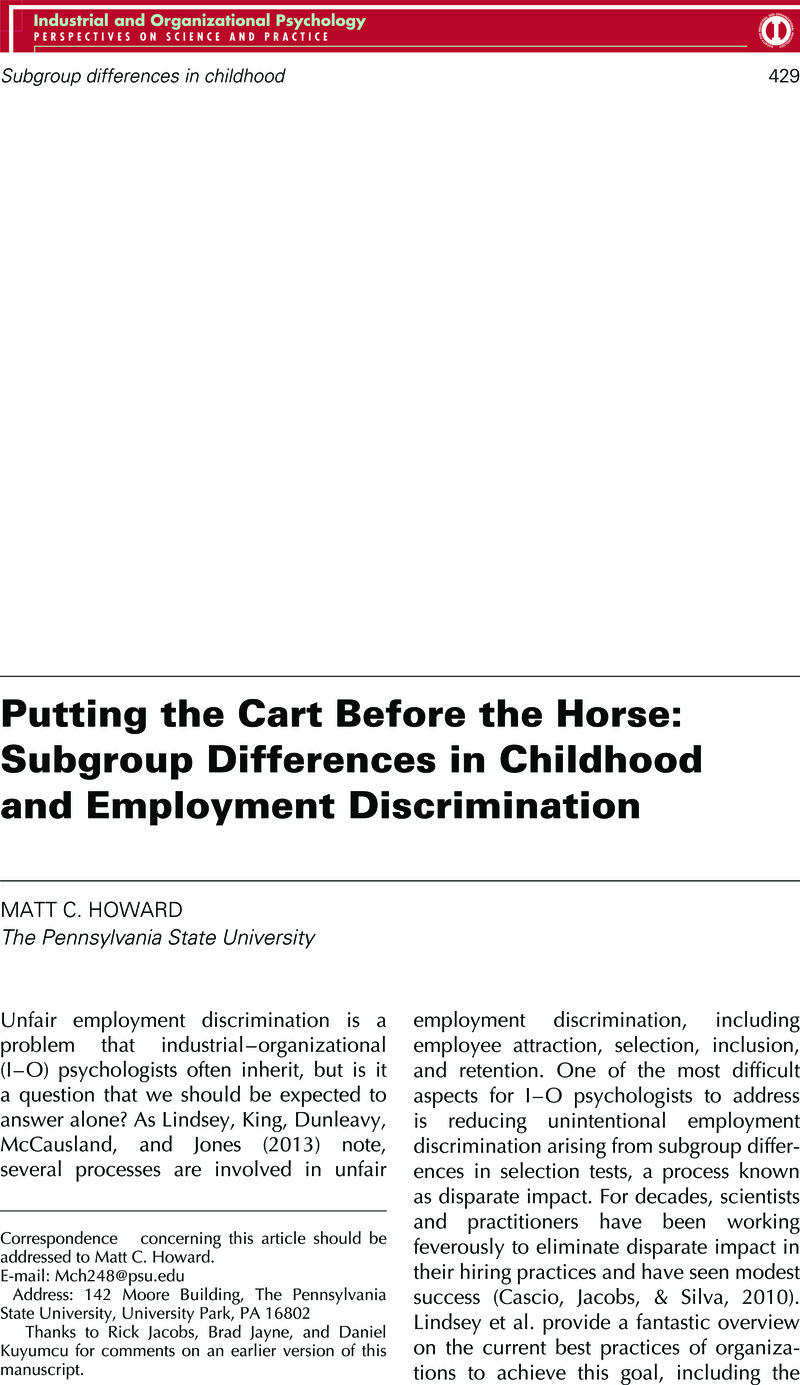No CrossRef data available.
Article contents
Putting the Cart Before the Horse: Subgroup Differences in Childhood and Employment Discrimination
Published online by Cambridge University Press: 07 January 2015
Abstract
An abstract is not available for this content so a preview has been provided. Please use the Get access link above for information on how to access this content.

- Type
- Commentaries
- Information
- Copyright
- Copyright © Society for Industrial and Organizational Psychology 2013
References
Bradley, R. H., & Corwyn, R. F. (2002). Socioeconomic status and child development. Annual Review of Psychology, 53(1), 371–399.Google Scholar
Campbell, F. A., Pungello, E. P., Miller-Johnson, S., Burchinal, M., & Ramey, C. T. (2001). The development of cognitive and academic abilities: Growth curves from an early childhood educational experiment. Developmental Psychology, 37(2), 231–242. doi: 10.1037/0012-1649.37.2.231Google Scholar
Cascio, W. F., Jacobs, R., & Silva, J. (2010). Validity, utility, and adverse impact: Practical implications from 30 years of data (pp. 271–288). New York, NY: Routledge/Taylor & Francis Group.Google Scholar
Dreger, R. M. (1985). On Gerard on “school desegregation.” American Psychologist, 40(1), 124–125. doi: 10.1037/0003-066X.40.1.124Google Scholar
Hoff, E. (2013). Interpreting the early language trajectories of children from low-SES and language minority homes: Implications for closing achievement gaps. Developmental Psychology, 49(1), 4–14. doi: 10.1037/a0027238Google Scholar
Lindsey, A., King, E., McCausland, T., Jones, K., & Dunleavy, E. (2013). What we know and don't: Eradicating employment discrimination 50 years after the Civil Rights Act. Industrial and Organizational Psychology: Perspectives on Science and Practice, 6(4), 391–413.Google Scholar
Lonigan, C. J., Farver, J. M., Nakamoto, J., & Eppe, S. (2013). Developmental trajectories of preschool early literacy skills: A comparison of language-minority and monolingual-English children. Developmental Psychology. doi: 10.1037/a0031408Google Scholar
Mendez, J. L. (2010). How can parents get involved in preschool? barriers and engagement in education by ethnic minority parents of children attending head start. Cultural Diversity and Ethnic Minority Psychology, 16(1), 26–36. doi: 10.1037/a0016258Google Scholar
Murphy, K. R., & Jacobs, R. R. (2012). Using effect size measures to reform the determination of adverse impact in equal employment litigation. Psychology, Public Policy, and Law, 18(3), 477–499. doi: 10.1037/a0026350Google Scholar
Sackett, P. R., & Shen, W. (2010). Subgroup differences on cognitive tests in contexts other than personnel selection (pp. 323–346). New York, NY: Routledge/Taylor & Francis Group.Google Scholar
Taylor, A. Z., & Graham, S. (2007). An examination of the relationship between achievement values and perceptions of barriers among low-SES African American and Latino students. Journal of Educational Psychology, 99(1), 52–64. doi: 10.1037/0022-0663.99.1.52Google Scholar
Vinci, Y. (2012). President releases FY13 funding proposal for head start. Retrieved from http://www.nhsa.org/statement_on_fy2013_funding_proposalGoogle Scholar


